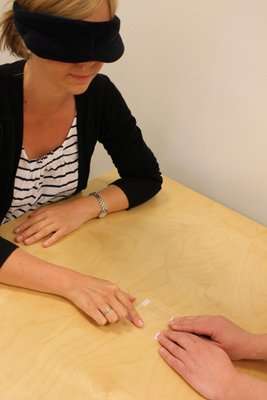New potential for touch screens found at your fingertips

Our sense of touch is clearly more acute than many realize. A new study by Swedish scientists demystifies the "unknown sense" with first-ever measurements of human tactile perception.
In a ground-breaking study, Swedish scientists have shown that people can detect nano-scale wrinkles while running their fingers upon a seemingly smooth surface. The findings could lead such advances as touch screens for the visually impaired and other products, says one of the researchers from KTH Royal Institute of Technology in Stockholm.
The study marks the first time that scientists have quantified how people feel, in terms of a physical property. One of the authors, Mark Rutland, Professor of Surface Chemistry, says that the human finger can discriminate between surfaces patterned with ridges as small as 13 nanometres in amplitude and non-patterned surfaces.
"This means that, if your finger was the size of the Earth, you could feel the difference between houses from cars," Rutland says. "That is one of the most enjoyable aspects of this research. We discovered that a human being can feel a bump corresponding to the size of a very large molecule."
The research team consisted of Rutland and KTH PhD student Lisa Skedung, and psychologist Birgitta Berglund and PhD student Martin Arvidsson from Stockholm Universiy. Their paper, "Feeling Small: Exploring the Tactile Perception Limits," was published on September 12 in Scientific Reports. The research was financed by a grant from Vinnova and the Knowledge Foundation to the SP Technical Research Institute of Sweden. Rutland says that the project will pursue applications of the research together with SP.
The study highlights the importance of surface friction and wrinkle wavelength, or wrinkle width – in the tactile perception of fine textures.
When a finger is drawn over a surface, vibrations occur in the finger. People feel these vibrations differently on different structures. The friction properties of the surface control how hard we press on the surface as we explore it. A high friction surface requires us to press less to achieve the optimum friction force.
"This is the breakthrough that allows us to design how things feel and are perceived," he says. "It allows, for example, for a certain portion of a touch screen on a smartphone to be designed to feel differently by vibration."
The research could inform the development of the sense of touch in robotics and virtual reality. A plastic touch screen surface could be made to feel like another material, such as fabric or wood, for example. The findings also enable differentiation in product packaging, or in the products themselves. A shampoo, for example, can be designed to change the feel of one's hair.
With the collaboration of National Institute of Standards and Technology (NIST) material science labs, Rutland and his colleagues produced 16 chemically-identical surfaces with wrinkle wavelengths (or wrinkle widths) ranging from 300 nanometres to 90 micrometres, and amplitudes (or wrinkle heights) of between seven nanometres and 4.5 micrometres, as well as two non-patterned surfaces. The participants were presented with random pairs of surfaces and asked to run their dominant index finger across each one in a designated direction, which was perpendicular to the groove, before rating the similarity of the two surfaces.
The smallest pattern that could be distinguished from the non-patterned surface had grooves with a wavelength of 760 nanometres and an amplitude of only 13 nanometres.
Rutland says that by bringing together professors and PhD students from two different disciplines – surface chemistry and psychology – the team succeeded in creating "a truly psycho-physical study."
"The important thing is that touch was previously the unknown sense," Rutland says. "To make the analogy with vision, it is as if we have just revealed how we perceive colour.
"Now we can start using this knowledge for tactile aesthetics in the same way that colours and intensity can be combined for visual aesthetics."
Journal information: Scientific Reports
Provided by KTH Royal Institute of Technology


















